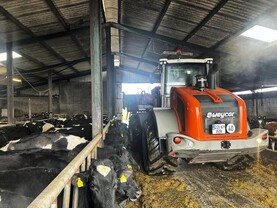As December draws to a close, cattle will be halfway through the winter housing period.
Therefore, now is a good time to carry out another fodder budget to see how much silage is still on farm.
Hopefully, fodder stocks will last until all cattle go back to grass.
But taking a stock count in mid-winter will give more time to take action if supplies are likely to run short.
The Irish Farmers Journal has a fodder app online that farmers can access at https://www.farmersjournal.ie/toolbox/fodder.php.
Simply input stock numbers, clamp measurements and the number of bales to work out how much forage is currently on farm.
Manual
To manually calculate fodder stocks, measure the length, width and average height of the clamp in metres.
Multiply these figures to get cubic capacity, then divide by 1.35 to convert this figure to tonnes of silage.
Count up the number of round bales and multiply by 0.9 to get the tonnage. Add this to the amount of pit silage.
Cattle demand
Dry spring-calving cows will eat around 900kg to 1t of silage every month on a per-head basis, as will finishing cattle.
Cows in milk will eat around 1.4t to 1.5t/head every month, with weanlings having a monthly intake around 0.75t/head.
Work out what each stock group will eat from January until the typical turnout date.
Supply
If stock demand exceeds what the silage volume in the pit and bale form, then steps need to be taken now.
These include offloading empty cows or late spring-calving cows, increasing concentrate feed levels to finishing cattle or buying in silage now.
Bought-in silage can be variable in terms of quality. This can be targeted to dry cows or store cattle in January and February, leaving better-quality silage for finishing animals and cows after calving.
Read more
Making the most of quality silage on Tullamore Farm
Farmer Writes: challenging times to sell weanlings
As December draws to a close, cattle will be halfway through the winter housing period.
Therefore, now is a good time to carry out another fodder budget to see how much silage is still on farm.
Hopefully, fodder stocks will last until all cattle go back to grass.
But taking a stock count in mid-winter will give more time to take action if supplies are likely to run short.
The Irish Farmers Journal has a fodder app online that farmers can access at https://www.farmersjournal.ie/toolbox/fodder.php.
Simply input stock numbers, clamp measurements and the number of bales to work out how much forage is currently on farm.
Manual
To manually calculate fodder stocks, measure the length, width and average height of the clamp in metres.
Multiply these figures to get cubic capacity, then divide by 1.35 to convert this figure to tonnes of silage.
Count up the number of round bales and multiply by 0.9 to get the tonnage. Add this to the amount of pit silage.
Cattle demand
Dry spring-calving cows will eat around 900kg to 1t of silage every month on a per-head basis, as will finishing cattle.
Cows in milk will eat around 1.4t to 1.5t/head every month, with weanlings having a monthly intake around 0.75t/head.
Work out what each stock group will eat from January until the typical turnout date.
Supply
If stock demand exceeds what the silage volume in the pit and bale form, then steps need to be taken now.
These include offloading empty cows or late spring-calving cows, increasing concentrate feed levels to finishing cattle or buying in silage now.
Bought-in silage can be variable in terms of quality. This can be targeted to dry cows or store cattle in January and February, leaving better-quality silage for finishing animals and cows after calving.
Read more
Making the most of quality silage on Tullamore Farm
Farmer Writes: challenging times to sell weanlings






 This is a subscriber-only article
This is a subscriber-only article










SHARING OPTIONS: